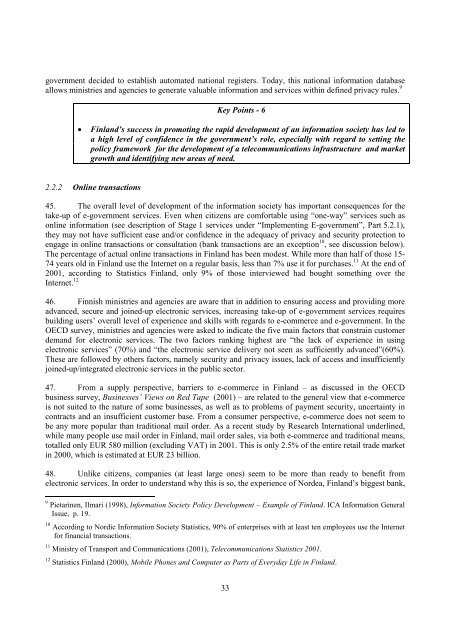e-GOVERNMENT IN FINLAND - ePractice.eu
e-GOVERNMENT IN FINLAND - ePractice.eu
e-GOVERNMENT IN FINLAND - ePractice.eu
Create successful ePaper yourself
Turn your PDF publications into a flip-book with our unique Google optimized e-Paper software.
government decided to establish automated national registers. Today, this national information database<br />
allows ministries and agencies to generate valuable information and services within defined privacy rules. 9<br />
Key Points - 6<br />
x Finland’s success in promoting the rapid development of an information society has led to<br />
a high level of confidence in the government’s role, especially with regard to setting the<br />
policy framework for the development of a telecommunications infrastructure and market<br />
growth and identifying new areas of need.<br />
2.2.2 Online transactions<br />
45. The overall level of development of the information society has important consequences for the<br />
take-up of e-government services. Even when citizens are comfortable using “one-way” services such as<br />
online information (see description of Stage 1 services under “Implementing E-government”, Part 5.2.1),<br />
they may not have sufficient ease and/or confidence in the adequacy of privacy and security protection to<br />
engage in online transactions or consultation (bank transactions are an exception 10 , see discussion below).<br />
The percentage of actual online transactions in Finland has been modest. While more than half of those 15-<br />
74 years old in Finland use the Internet on a regular basis, less than 7% use it for purchases. 11 At the end of<br />
2001, according to Statistics Finland, only 9% of those interviewed had bought something over the<br />
Internet. 12<br />
46. Finnish ministries and agencies are aware that in addition to ensuring access and providing more<br />
advanced, secure and joined-up electronic services, increasing take-up of e-government services requires<br />
building users’ overall level of experience and skills with regards to e-commerce and e-government. In the<br />
OECD survey, ministries and agencies were asked to indicate the five main factors that constrain customer<br />
demand for electronic services. The two factors ranking highest are “the lack of experience in using<br />
electronic services” (70%) and “the electronic service delivery not seen as sufficiently advanced”(60%).<br />
These are followed by others factors, namely security and privacy issues, lack of access and insufficiently<br />
joined-up/integrated electronic services in the public sector.<br />
47. From a supply perspective, barriers to e-commerce in Finland – as discussed in the OECD<br />
business survey, Businesses’ Views on Red Tape (2001) – are related to the general view that e-commerce<br />
is not suited to the nature of some businesses, as well as to problems of payment security, uncertainty in<br />
contracts and an insufficient customer base. From a consumer perspective, e-commerce does not seem to<br />
be any more popular than traditional mail order. As a recent study by Research International underlined,<br />
while many people use mail order in Finland, mail order sales, via both e-commerce and traditional means,<br />
totalled only EUR 580 million (excluding VAT) in 2001. This is only 2.5% of the entire retail trade market<br />
in 2000, which is estimated at EUR 23 billion.<br />
48. Unlike citizens, companies (at least large ones) seem to be more than ready to benefit from<br />
electronic services. In order to understand why this is so, the experience of Nordea, Finland’s biggest bank,<br />
9<br />
Pietarinen, Ilmari (1998), Information Society Policy Development – Example of Finland. ICA Information General<br />
Issue, p. 19.<br />
10<br />
According to Nordic Information Society Statistics, 90% of enterprises with at least ten employees use the Internet<br />
for financial transactions.<br />
11 Ministry of Transport and Communications (2001), Telecommunications Statistics 2001.<br />
12 Statistics Finland (2000), Mobile Phones and Computer as Parts of Everyday Life in Finland.<br />
33
















